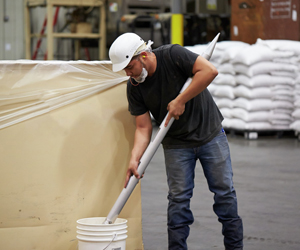
As the EU continues to withdraw the registration of certain compounds, there are many unknowns as to how this regulation will impact the almond industry.
As bloom heads into full swing, almond growers and handlers are receiving questions from the trade in the European Union (EU), who is suddenly asking that certain fungicides or other pesticides not be used in the orchard.
Why the sudden questions?
In short, the EU is removing some compounds, or pesticides, from EU growers’ use, and then lowering the associated MRLs which makes it harder for non-EU growers who ship product to the EU to use the compounds. This action is based on the EU’s legislation from 2008 that requires any pesticide that meets one or more hazard criteria (such as a carcinogen, endocrine disruptor, etc.) be removed from growers’ use regardless of whether there is enough exposure to the compound to be a risk. Subsequent to ending the registration of these compounds within the EU, EU officials reduce any associated Maximum Residue Levels (MRLs, or tolerances) to 0.01 ppm — the default MRL — which tends to be close to the limit of detection for most compounds.
Given the long shelf life of almonds, compounds whose registration is withdrawn this year in the EU will likely have the default MRLs in place sometime within the next 18 months, when this year’s crop will still be in the supply chain within the EU. Thus, EU buyers are concerned about the use of such pesticides.
During last year’s bloom, we experienced one of the first ripple effects of these EU regulations regarding the compound Rovral® (iprodione) with EU trade concerned about its use during the 2018 growing season.. Last year, the EU withdrew the registration of iprodione for use in the EU as of March 2018, with a “last use” date of early June 2018. Then, in January 2019, the EU published an official notice that the lower default (MRL) of 0.01 ppm for iprodione will take effect on July 31, 2019. What’s more, currently the EU doesn’t provide any “channels of trade” provisions.
What does this mean for almond growers?
“Essentially, the EU is stating that any food item found to exceed the MRL of 0.01 ppm for iprodione after July 30, 2019, will be considered adulterated, even if the product was produced and imported when the higher MRL was still in effect,” said Gabriele Ludwig, director of Sustainability and Environmental Affairs at the Almond Board. This explains why EU buyers are concerned.
Since this first Rovral ripple effect, the EU has withdrawn the registration for several additional compounds for use. Whether the withdrawal of registration in the EU affects the ability for California almond growers to continue to use the affected compounds, which are still legal for use within the U.S., depends on several factors. For one, tree nuts surrounded by hulls and shells tend to have low residues, therefore the current EU MRL may already be set at 0.01 ppm. In that case, the withdrawal and subsequent lowering of the MRLs within the EU doesn’t change anything for almond growers. Growers can check current MRLs at the Global MRL database.
Another question is whether any residues of the compound of concern have been detected in almonds — this may be a question for growers to ask their handlers. In the case of Rovral, there is data indicating that occasionally a residue above 0.01 ppm is detected, which could cause concern in the EU once the MRL is lowered.
The next question is whether the compound can be applied in such a way as to avoid the chance of residues exceeding the default MRL. This tactic is tricky, as generally there is little data about what influences the chances of a residue appearing in almonds. A general rule of thumb is that the earlier a compound is applied in the growing season, the less chance there is of it showing up after harvest.
Multiple industries, both within the EU and in producing countries, have worked to prompt the EU to provide a more flexible enforcement system that accounts for the different lengths of time that various foods can be in the supply chain. However, at this time the EU has been unwilling to reconsider their current system.
Growers with questions regarding the EU’s official rulings may contact Ludwig at gludwig@almondboard.com. Interested parties are also encouraged to check out current MRLs Global MRL database, found at globalmrl.com/db#login.